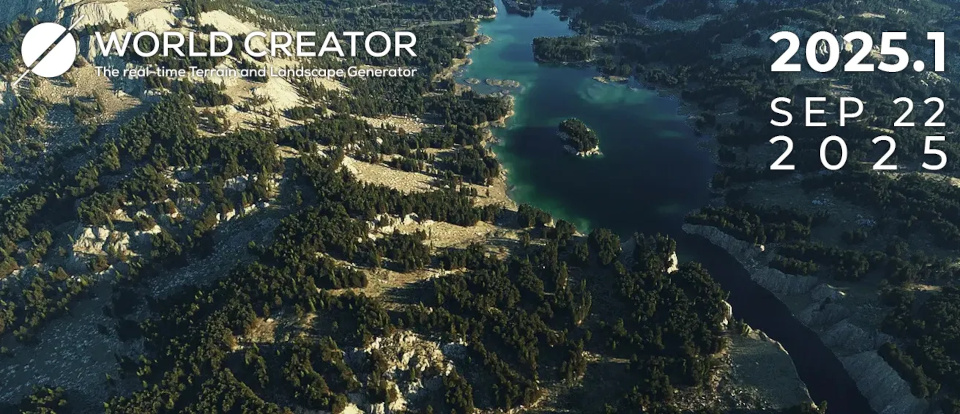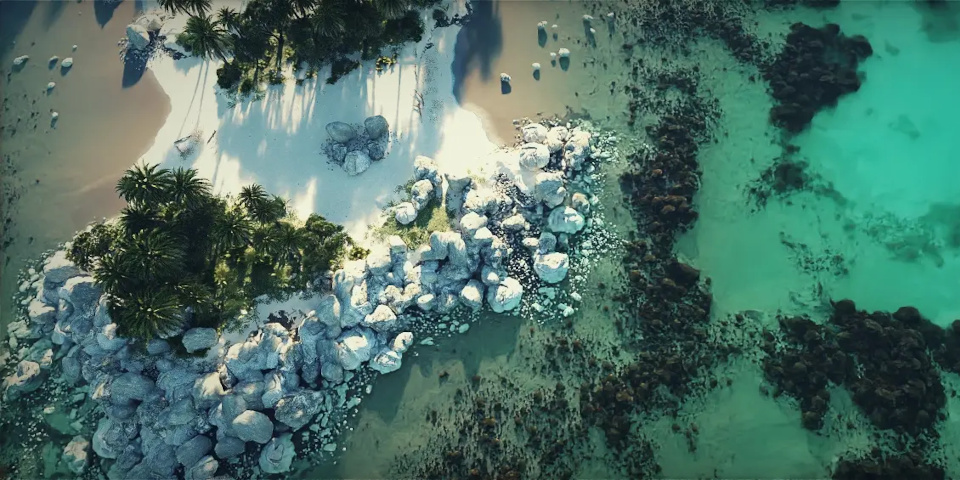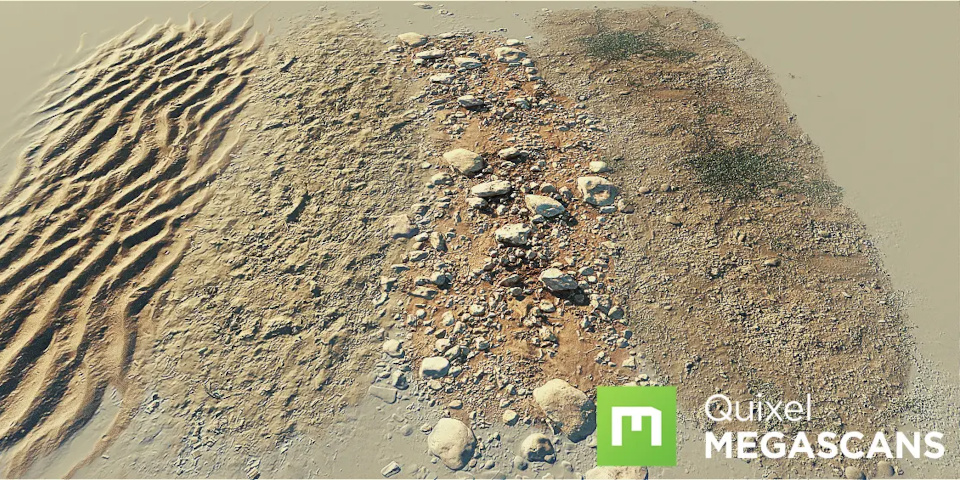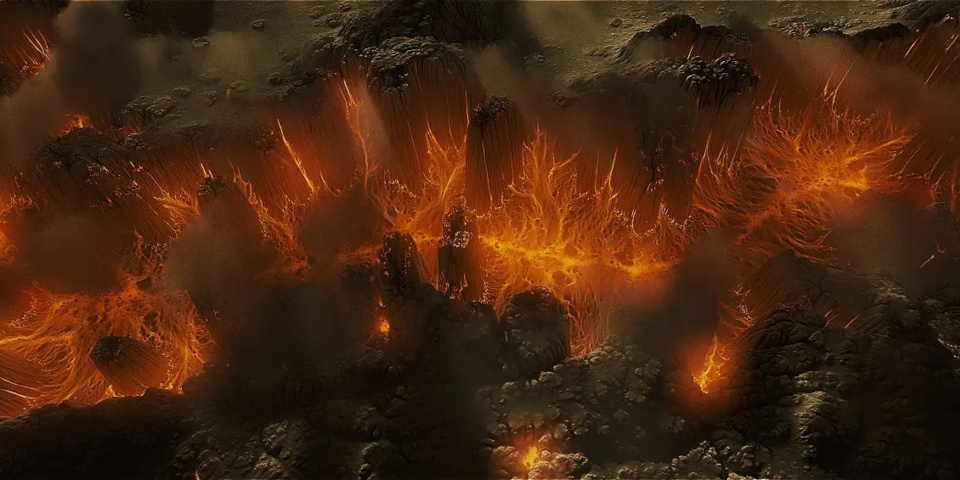BiteTheBytes releases World Creator 2025.1

Originally posted on 23 September, and updated with more details on 6 October 2025.
BiteTheBytes has released World Creator 2025.1, a major update to its GPU-based terrain-generation software for game development, motion graphics and VFX work.
Key changes include a new Biome system, enabling users to set up entire ecosystems and paint them onto terrain, and the option to import and scatter custom 3D assets.
There are also updates to the material system, to viewport rendering – and even new options to export terrains from World Creator for use as custom Grand Theft Auto V maps.
BiteTheBytes has also updated its pricing model, changing the Indie perpetual license, introducing a new Studio license tier, and reducing the number of subscription options available.
A procedural GPU-based terrain generator used by leading games and VFX studios
World Creator enables artists to create terrain through a combination of procedural and manual workflows.
Artists can create terrain using a layer-based workflow, sculpting the basic 3D forms, and generating linear land forms like mountain ranges, rivers and roads along vector paths.
The terrain can be modified using filters, including those mimicking the effects of erosion and sediment deposition, previewing the results using World Creator’s built-in ray tracing renderer.
Users can export terrain to DCC applications and game engines in 3D formats like OBJ, FBX and glTF, or as 2D texture maps, including height maps and flow maps, with support for 32-bit EXRs.
The software has been used by artists at games and VFX studios including Blizzard Entertainment, Crytek, Blur Studio and Cinesite.
New in World Creator 2025.1: create Biomes and paint them onto terrain
The headline change in World Creator 2025.1 is the new Biome system, which enables artists to build complete ecosystems – forests, deserts, tundra and the like – and paint them into terrain.
World Creator then “takes care of everything” ordering and blending biomes in real time.
The distribution of biomes within the terrain can be exported from World Creator as a 2D map.
Biomes themselves can be defined using a combination of filters, objects and materials, and can contain their own simulations, controlled by masks or procedural rules.

Import your own custom 3D assets and place or scatter them onto terrain
Another key change is the option to import custom 3D models like rocks or vegetation, and distribute them on terrain: either through procedural scattering, or by placing them manually.
For manual placement, users can position models individually, or paint them onto the terrain.
When placing assets procedurally, users can scatter based on parameters like terrain height or angle, use collision exclusion to prevent overlaps, and use noise to randomize placement.
Scattered objects can have their own unique shading styles, and distribution gradients can be used to add “subtle color variation”, helping to increase realism further.
Scattering can also be done at sub-object level to add secondary details to the main objects being scattered: for example, to add moss to rocks, or vines to trees.
The scatter placement data can then be exported to game engines or other DCC applications as object instance maps.

Import 3D files including Megascans assets
Models can be imported in “virtually any format”, including FBX, GLB and OBJ.
World Creator also now directly supports assets from the Megascans library of scanned real-world objects, now available through Fab, Epic Games’ new online marketplace.
BiteTheBytes has also created its own pack of readymade 3D assets, including trees, grasses, bushes, rocks, available with Professional, Studio and Enterprise licenses – about which, more later.

Updates to the material system, including support for emissive materials and displacement
World Creator’s material system has been updated, making it possible to combine “color, textures, Adobe Substance materials and gradients in one single material”.
It also now supports emissive materials, for anything from lava flows to magical effects.
When importing materials, it is now possible to pack the files into .zip archives, with World Creator automatically detecting and assigning the texture maps correctly.
New viewport rendering and post-processing options
World Creator 2025.1 also introduces a new real-time denoiser, to help remove visual noise while navigating the viewports; and the option to use custom viewport resolution settings.
For manipulating renders, the update also adds “many new image-processing filters” and adds support for LUTs for further image processing.
Other new features and performance updates
Other new features include World Scaler, which makes it possible to adjust the proportions of an entire world with a single slider.
Objects, distributions, materials and procedural noises all scale automatically.
A new Scene Layer Node makes it possible to combine procedural generation with manually placed objects and cameras, for a more flexible workflow.
And rather than rendering videos of terrain in external applications, it is now possible to create simple camera flythroughs directly inside World Creator.
There are also new Filters for Spike Removal and creating Cliffs.
Support for the GTAV modding community
Other, less expected, changes include support for the Grand Theft Auto V modding community.
It is now possible to “design your own maps in World Creator and bring them directly into your custom GTAV server” via FiveM.
It is also now possible to export scenes to GTAV map editor CodeWalker from World Creator’s Blender bridge plugin.
Changes to World Creator’s pricing tiers and licensing model
BiteTheBytes has also updated World Creator’s license tiers for the second time in a year.
The $149 Indie license, previously for artists earning under $100,000/year, is now only available to artists earning under $50,000/year, and does not include the new object scattering features.
However, the maximum resolution for exported terrain has been raised from 4K to 8K.
The $249 Professional license is now restricted to individual artists, not studios, but the $250,000/year revenue limit has been removed.
There is also a new $499 Studio license, for studios with revenue under $1,000,000/year.
As a result, the revenue cap for the existing Enterprise license has been raised from $500,000/year to $1,000,000/year, but the price has been reduced slightly, to $1,699.
Outside of perpetual licenses, subscriptions are no longer available for Indie or Professional users, only for Studio and Enterprise; and monthly rentals have been dropped entirely.
BiteTheBytes is also currently offering time-limited lifetime licenses – World Creator 2025.1, plus “all future updates at no cost” – which will be available for four weeks after the release.
Availability and system requirements
World Creator 2025.1 is available for Windows 7+ only. Integration plugins are available for Blender, Cinema 4D, Houdini, Unity and Unreal Engine.
For individual artists with revenue under $50,000/year, perpetual Indie licenses cost $149, and are limited to 8K resolution, and lack the object scattering toolset.
For individual artists with revenue over $50,000/year, perpetual Professional licenses cost $249.
For studios with revenue under $1,000,000/year, perpetual Studio licenses cost $499. Rental costs $249/year.
For studios with revenue over $1,000,000/year, perpetual Enterprise licenses cost $1,669. Rental costs $1,289.88/year.
Lifetime licenses cost $449 for Indie users, $749 for Professional users, $1,499 for Studio users, and $4,999 for Enterprise users.
Read a list of new features in World Creator 2025.1 in the online release notes
Read more about the new features in World Creator 2025.1 on the product website
Have your say on this story by following CG Channel on Facebook, Instagram and X (formerly Twitter). As well as being able to comment on stories, followers of our social media accounts can see videos we don’t post on the site itself, including making-ofs for the latest VFX movies, animations, games cinematics and motion graphics projects.
